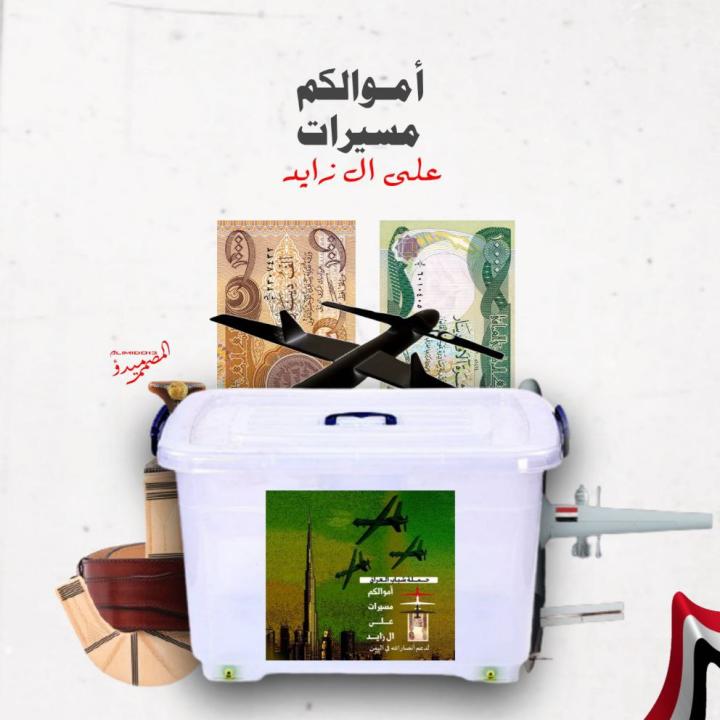
Kataib Hezbollah Behind "Grassroots" Iraqi Fundraising for Yemen

The Iran-backed militia tried to make its solo effort to boost the Houthi drone arsenal look like a widely coordinated and highly popular campaign, whereas it was anything but.
On January 23, Kataib Hezbollah (KH) launched a fundraising campaign purporting to help the Yemeni Houthi movement acquire more drones intended for attacks against the United Arab Emirates. The campaign was advertised as a "grassroots" initiative and named hamlat shabab al-Iraq (Iraqi youth campaign). But clear and convincing evidence suggests it was in fact a KH-organized initiative and not that successful.
The campaign was launched by Amir al-Musawi, the spokesman for Sharia Youth Gathering (Tajamma Shabab al-Sharia, or TSS), an umbrella organization controlled by KH. In a video clip circulated on Iraqi muqawama (resistance) social media, Musawi stated: “After a series of continuous assaults by those who made the Zionist dream come true [referring to the Emiratis] against the oppressed and victorious Yemeni people, the honorable sons of Iraq had to...support their Yemeni brothers. Therefore, we will launch a big campaign under the slogan amwalokum mosayarat [your money will turn to drones]...to gather money for the Yemeni people to buy drones—drones that will be Ababil and whips to punish...al-Salul and the House of Zayed [the UAE ruling family]." ("Al-Salul" is a derogatory term used to describe the rulers of Saudi Arabia. "Ababil" refers to the miraculous flock of birds described in the Quran as protecting the Kaaba by dropping stones on an army invading Mecca.)
The Musawi clip was posted with two mobile numbers for people to donate money (Figure 1). Although TSS social media accounts did not post the clip itself, the organization's Telegram channel was the most active muqawama channel promoting the campaign. TSS also produced video clips showing young men erecting stands in the street with boxes for people to donate (Figure 2).
Other KH social media channels actively advertised the campaign as well. Tahalof Thawrat al-Ishrin al-Thaniyah (Alliance of the Second Revolt of 1920)—a tribal group that appears to be tied to KH based on the content of its material—was among the small number of Telegram channels posting video clips promoting the fundraising campaign. Some of these clips were reposted by TSS (Figure 3).
Additionally, some of the graphics used in the campaign clearly indicate that KH was the organizer. Mido, the tag name for one of the main muqawama graphic designers, posted an image featuring a fighter wearing a uniform that resembles KH's signature attire: a boonie hat and a military chest name tape showing the "313" nomenclature, a practice that is closely and almost exclusively associated with KH personnel (Figure 4).
The "313" has significant religious connotations for Shia Muslims, indicating the number of warriors who will accompany Imam Mahdi when he reemerges from his hidden existence. Many Shia militias in Iraq use it to name their units or print it on their attire, but its use on boonie hats and chest name tapes seems specific to KH.
Notably, the biggest pledged support to the campaign came from KH official Abu Ali al-Askari. On January 28, he announced that his militia would donate one billion Iraqi dinars to the campaign ($685,000 in USD). The statement was posted on the KH Twitter account Kaf, using a hashtag composed of the same drone phrase uttered in the Musawi video (amwalokum mosayarat) (Figure 5).
A One-Militia Show
Despite this strong push, the fundraising campaign does not appear to have been very successful at mobilizing support and money from the general public or the wider muqawama. No other militias publicly donated to the cause or even offered support via their television channels. While KH’s al-Etejah TV covered the campaign, other militia channels such as Asaib Ahl al-Haq’s al-Ahd TV and Harakat Hezbollah al-Nujaba’s al-Nujaba TV were largely silent.
Non-KH social media accounts likewise paid little attention. For example, Sabereen News did not mention the campaign until four days after it launched, and its coverage consisted of a single Telegram post. Such minimalist reactions strongly suggest a deliberate withholding of support.
Why would KH be left standing alone when raising the profile of a favorite pan-muqawama issue like the Yemen war? One explanation may be the explicitly terrorist nature of this appeal, i.e., raising money to buy drones for attacking the UAE. Other media organs may have wished to avoid this level of implication in terrorist weapons procurement and attacks on the UAE, a nation whose reach is substantial in regional politics, business, travel, and banking. Another explanation may be KH's habit of grandstanding during endeavors that are presented as pan-muqawama efforts but in reality seem intended to benefit KH more than anyone else. Whatever the case, this fundraiser demonstrated the growing difficulty the muqawama have had in coordinating even basic propaganda campaigns on issues that should be of considerable mutual interest.









